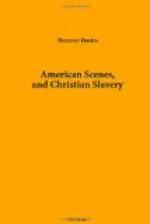As education is the great question of the day, I must not omit to make a few remarks on the Primary Schools of the United States. There is no national system of education in America. Congress does not interfere in the matter, except in the “Territories” before they become “States.” The States of the Union are so many distinct Republics, and, in the matter of education, as in all their internal affairs, are left entirely to take their own measures. With regard to education, no two States act precisely alike. If we glance at the States of Massachusetts, New York, and Ohio, we shall, however, discover the three great types of what in this respect generally prevails throughout the States.
MASSACHUSETTS.—Scarcely had the “Pilgrims” been half-a-dozen years in their wilderness home before they began to make what they deemed a suitable provision for the instruction of their children. They adopted the same principle in reference to education and religion—that of taxation. A general tax was not imposed; but the people in the various townships were empowered to tax themselves to a certain amount, and to manage the whole affair by means of their own “select men.” But, although this law has continued for 200 years, the people have always done far more than it required. In Boston, for instance, the law demands only 3,000 dollars a year, but not less than 60,000 dollars is raised and applied! So that here we have a noble proof, not so much of the effect of government interference, as of the efficiency of the voluntary principle in providing education for the young. The people of Massachusetts, and indeed of all the New England States, are doubtless the best educated in the world. Not one in a thousand of those born here grows up unable to read and write.
The calumniated “Pilgrims” were thus early attentive to the importance of education; and their system had been in full operation for between thirty and forty years, when, in 1670, Sir William Berkley, Governor of Virginia, the stronghold of the Anglican Church, thus devoutly addressed the “Lords of Plantations in England:”—“I thank God there are no free schools nor printing, and I hope we shall not have them these hundred years; for learning has brought disobedience and heresy and sects into the world, and printing has divulged them, and libels against the best government. God keep us from both!”
The system of Massachusetts may be regarded as a type of what prevails in the six New England States, except Connecticut, where there is a State fund of upwards of 2,000,000 dollars, yielding an annual dividend of about 120,000 dollars for school purposes.
NEW YORK.—In this State a large fund for schools has been created by the sale of public land. The proceeds of this fund are annually distributed in such a way as to secure the raising by local efforts of at least three times the amount for the same object. This fund is thus used as a gentle stimulant to local exertions. The system described will convey a notion of what exists in the middle States.




